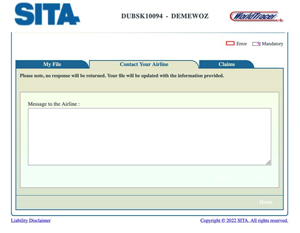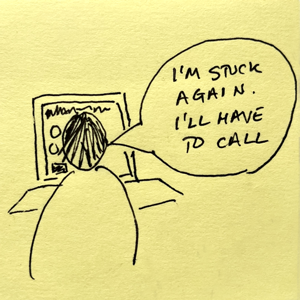
Recently I saw a tweet from Abebe Birhane, a leading researcher in the area of artificial intelligence, machine learning, and ethics. She’s a busy woman and has better things to do, but she’d had this very frustrating experience:
“Dear @SAS I lost a luggage flying from Addis to Dublin via Stockroom on 28th Aug & it’s been a nightmare trying to get it back. What’s absolutely unacceptable is for your luggage handlers to have “contact your arline” box with no feature to actually send the message. Pls respond” @abebeb on Twitter
Nearly a month after that luggage got lost, Abeba is still frustrated. Neither SAS nor their baggage hander SITA has helped. When I asked her permission to share this story, she said:
“Yes, please go ahead and use it. … No bag! No response! No information! No idea! Just frustration”
Why don’t forms get fixed? Why do organisations like SAS and SITA allow their customers to become so alienated that they take to social media to vent? Why are organisations willing to pour millions into an advertising campaign that leads you to a website with an awful form? Why are there so many government forms out there that people have to suffer through? Why has a decade or more of ‘digital transformation’ failed to make forms easier to use?
The costs of not fixing the forms, right now, are huge. Let’s ignore the cost to the people who have to fill in the bad forms – their delays, the time they waste that stops them doing more useful things, their extra costs of hiring people such as accountants to help them.
Let’s think only about the cost to the organisation that has the bad form: typically, a bad form is sucking up vast amounts of staff time as they deal with errors, plus the time of the people who have to deal with the calls that result.
Let’s think about the waste of time, and the dreary job, of the luckless person staffing the appointments desk in a hospital as they explained, obviously for at least the 20th time that day, that the form letter I’d been sent with directions about how to get to the hospital was in fact confirmation of the telephone appointment and yes, it was a telephone appointment and no, they didn’t know why the form letter hadn’t been changed yet.
And yet, forms do not get fixed. Let’s look at some of the excuses people give me for not fixing their forms.
Excuse: “We’re making everything digital so paper doesn’t matter”
I’ve heard ‘paper doesn’t matter’ more times than I care to remember when challenging people about their forms. Yet there will always be a proportion of your clients who need to use paper. They may not be able to afford a computer, or be able to access the digital version of your form at that particular moment; they may lack digital skills and find it easier and quicker to complete your form on paper; you may need a signature on the form – or require paper for any number of other reasons.
What’s more, when it comes to prototyping a new form, or improving an existing one, it’s much quicker and easier to do the work on paper and then create a digital version, than it is to do those things the other way around.
Fix those paper forms – then digitise the improved ones.
Excuse: “We don’t have time to fix the forms – we’re focusing on our digital transformation”
As the word ‘transformation’ suggests, becoming a digital organisation is not the work of a few days. Transforming your systems and processes, staff attitudes and skills, and customers’ expectations and behaviour, is going to take years.
In the meantime, you may have hundreds, thousands or even millions of people who are struggling with forms created in the pre-digital era. Your hard-to-complete forms are actually holding back transformation while staff are tied up dealing with confused or stressed customers.
If you can devote just one percent of your budget to fixing the forms today they’ll no longer be reducing the organisation’s capacity for change. And you’ll have a better place to start from with your new, digital future.
Excuse: “Fixing forms is too difficult”
Another thing I sometimes hear is that fixing bad forms is ‘too difficult’.
If it’s a paper form: see above.
But maybe you’re already doing digital forms. I’ve had this discussion many times with organisations that have proudly chosen a forms management or customer service management package from a vendor, shoe-horned their forms into it, and then forgotten about it. Sometimes: forgotten about it to the point where nobody really understands the package that they have bought, or maybe there’s only a tiny department (sometimes, a lone developer) who is trying to deal with all sorts of feature requests and changes and is too hard-pressed to do anything with the forms.
Finding and fixing usability problems, like bad forms, can be really quick and easy. For example, do this:
- Set aside a morning (about three hours)
- Watch a few people filling in one or more of your forms. Three people for an hour each is plenty.
- Ask yourself: “What’s the least we can do to make this easier?”
- Make those changes.
- Repeat from step 1. Once a month is good. Every two weeks, even better.
Steve Krug’s book ‘Rocket Surgery Made Easy‘ explains this simple process in more detail.
If you, too, are competing for time of a hard-pressed maintenance department: time box ‘the least we can do’. Work with them to pick a change that they can do in an hour or less.
If you can’t do the major fix because it means too much programming, try re-writing an error message or an instruction. An honest, clear explanation that someone can read right when they need it is much, much better than doing nothing.
You’ll very quickly learn what really matters to the people who are trying to use your forms, and you’ll even more quickly learn that small changes can help immensely.
Think of that awful SITA form: is it really that hard to add a button to it? I don’t think so, but if it genuinely is too hard then the whole form would be improved by changing it to an instruction about how to email.
Excuse: “Fixing forms is too expensive”
 I can’t say enough times that bad forms are really, really expensive. There are the physical costs such as paper or bandwidth costs when a form is unnecessarily long or complex, plus the costs of safely storing data which may not even be what your organisation intended to collect.
I can’t say enough times that bad forms are really, really expensive. There are the physical costs such as paper or bandwidth costs when a form is unnecessarily long or complex, plus the costs of safely storing data which may not even be what your organisation intended to collect.
Even more damaging to the business are the people costs. Frontline staff who have to deal with people who can’t understand or complete your form quickly become demoralised by having to repeat the same explanations over and over, or apologise for confusing instructions and messages.
On the other end of the phone or chat box are customers who learn to dread having to deal with your organisation, and come to each transaction in an anxious state of mind – further diminishing their ability to use the form.
It’s pretty clear that when you calculate those hidden costs, they are losing your business far more in time, energy, goodwill and money than it will to do the work now to fix the forms.
Don’t make excuses. Fix the forms.
I’m not asking you to do the best possible form. I’m not asking you to do a full digital transformation. I’m only asking you to set aside a morning every now and then.
Doing the ‘watch, choose a fix, make a fix’ sequence every month isn’t that demanding – and is massively better than never doing anything.
If you can get into a rhythm of going around that sequence every two weeks then you’ll be amazed at how quickly the investment repays itself.
